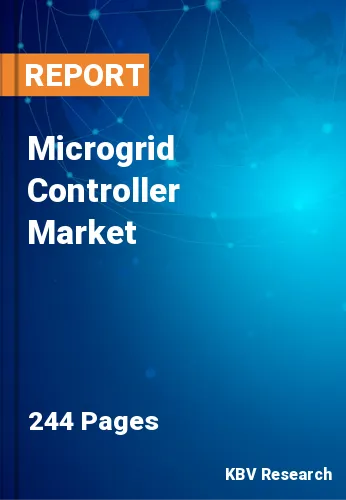The Global Microgrid Controller Market size is expected to reach $12.6 billion by 2028, rising at a market growth of 21.8% CAGR during the forecast period.
A microgrid is a network of interconnected workloads and distributed energy sources that behave with the grid as a single, controllable entity. To function in island mode or grid-connected mode, it can connect to and disconnect from the grid. Distributed energy sources including generators, storage, and controllable loads can be incorporated into microgrids.
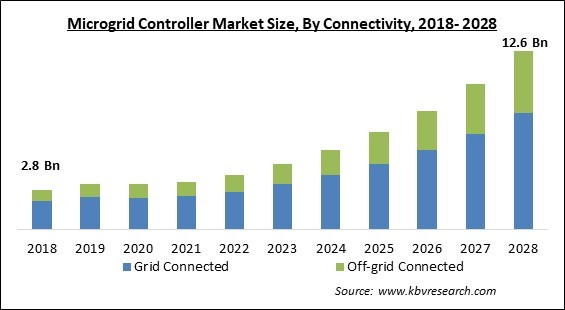
A microgrid controller is a system that manages the microgrid and specifies how and when to connect to/disconnect from the grid. When a system is islanded, actual and reactive power balance must be maintained immediately. Over a longer period, the control strategy must be used to decide how to allocate the resources. The allocation of resources is also done by a microgrid controller.
In the past, combined heat and power (CHP) systems powered by fossil fuels and generators with reciprocating engines were used to power microgrids. Nowadays, however, projects are utilizing more environmentally friendly resources, such as solar energy and energy storage. When emerging technologies like fuel cells and even small customizable nuclear reactors become commercially viable.
Microgrids can be powered by renewable energy sources, combustion turbines powered by natural gas or other sources. After weather- or protection outage hits the larger system, they can power crucial facilities. Additionally, microgrids can serve as the neighborhood's or a hospital's primary source of electricity. Many metropolitan areas are engaged in systems that can more effectively integrate generation assets and load, offer numerous users, and/or meet ecological or emergency response objectives.
The manufacturing and production activities across all industrial verticals have been significantly impacted by the COVID-19 outbreak. The governments of many countries have implemented a multitude of restrictions and lockdowns to deal with the problem. These elements have reduced industry employment and financial growth prospects. Due to the drop in demand for electricity, particularly for industrial operations, the necessity for microgrids and their operating systems significantly dropped during the pandemic.
Massive, distant power plants that use fossil fuels and are connected to centralized power grids produce electricity that is transmitted between different areas and nations. However, it has become more and more clear that these power plants have issues with ineffective power transmission. Conventional grids are susceptible to natural disasters, which typically cause network problems or blackouts. For instance, Typhoon Haiyan in the Philippines and Hurricane Sandy in the US, both caused widespread outages in urban centers like New York City and the Leyte Islands.
Microgrids can help their clients save money while also generating income. Through effective energy supply management, they lower expenses. By reselling energy and services to the grid, they generate income. As a result, consumers have a new level of power in the energy markets. Through their microgrids, they can now produce and control energy as well as consume it. Prosumers are the name for these clients. Ancillary services perform grid-supporting tasks like frequency regulation and spinning reserves.
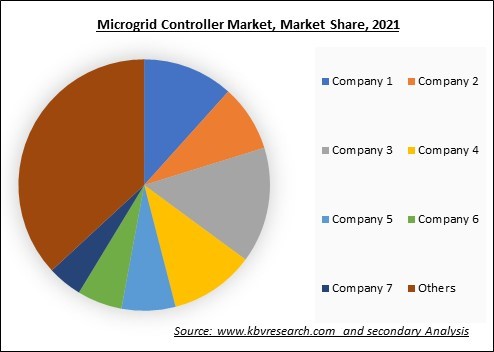
The leading players in the market are competing with diverse innovative offerings to remain competitive in the market. The below illustration shows the percentage of revenue shared by some of the leading companies in the market. The leading players of the market are adopting various strategies in order to cater demand coming from the different industries. The key developmental strategies in the market are Acquisitions.
Being relatively new, microgrid technology is currently too dynamic and unpredictable for regulatory frameworks. For example, rules and guidelines for integrating microgrids into the larger grid are still being developed. The acceptability of microgrids is restricted by the current framework structure. For instance, grid-connected power inverters must shut down when they detect grid problems according to IEEE Standard 1547.
Based on connectivity, the microgrid controller market is bifurcated into grid connected and off-grid connected. The grid-connected segment acquired the highest revenue share in the microgrid controller market in 2021. Microgrids that are connected to the grid are made up of several generators, sophisticated controllers, and distribution networks. In addition to increasing grid resilience, enhancing electricity quality, and reducing environmental impact, these technologies also have a number of additional advantages that drive demand.
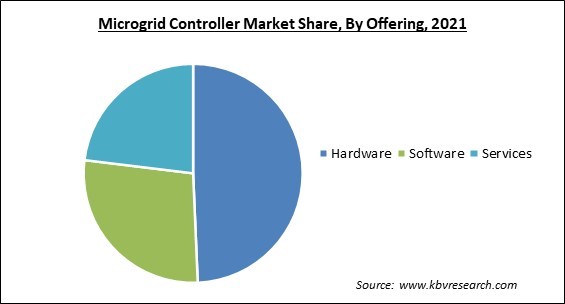
On the basis of offering, the microgrid controller market is divided into hardware, software, and services. The software segment witnessed a substantial revenue share in the microgrid controller market in 2021. A microgrid software is a comprehensive platform that enables project planning, visualization, and optimization for everyone from financiers to engineers and features integrated design stages.
Based on end-use application, the microgrid controller market is categorized into commercial & industrial, remote areas, military, government, utilities, manufacturing and healthcare. The military segment garnered a substantial revenue share in the microgrid controller market in 2021. For international military activities, power security is a crucial concern. Microgrids also improve physical security and cybersecurity, two major military issues, because they can run independently from the grid.
| Report Attribute | Details |
|---|---|
| Market size value in 2021 | USD 3.4 Billion |
| Market size forecast in 2028 | USD 12.6 Billion |
| Base Year | 2021 |
| Historical Period | 2018 to 2020 |
| Forecast Period | 2022 to 2028 |
| Revenue Growth Rate | CAGR of 21.8% from 2022 to 2028 |
| Number of Pages | 244 |
| Number of Tables | 384 |
| Report coverage | Market Trends, Revenue Estimation and Forecast, Segmentation Analysis, Regional and Country Breakdown, Competitive Landscape, Market Share Analysis, Companies Strategic Developments, Company Profiling |
| Segments covered | Connectivity, Offering, End User, Region |
| Country scope | US, Canada, Mexico, Germany, UK, France, Russia, Spain, Italy, China, Japan, India, South Korea, Singapore, Malaysia, Brazil, Argentina, UAE, Saudi Arabia, South Africa, Nigeria |
| Growth Drivers |
|
| Restraints |
|
On the basis of region, the microgrid controller market is analyzed across North America, Europe, Asia Pacific, and LAMEA. The North American region garnered the highest revenue share in the microgrid controller market in 2021. The significant expansion of microgrids in the region is being fueled by third-party administration of microgrids and a tendency toward smaller (less than 5 MW) repeatable modular systems.
Free Valuable Insights: Global Microgrid Controller Market size to reach USD 12.6 Billion by 2028
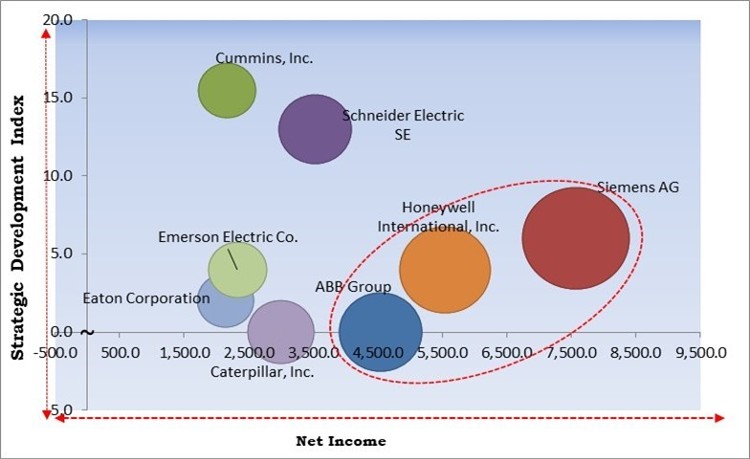
The major strategies followed by the market participants are Acquisitions. Based on the Analysis presented in the Cardinal matrix; Siemens AG, Honeywell International, Inc. and ABB Group are the forerunners in the Microgrid Controller Market. Companies such as Schneider Electric SE, Cummins, Inc., Emerson Electric Co. are some of the key innovators in Microgrid Controller Market.
The market research report covers the analysis of key stake holders of the market. Key companies profiled in the report include Siemens AG, General Electric (GE) Co., Schneider Electric SE, ABB Group, Honeywell International, Inc., Eaton Corporation, Caterpillar, Inc., S&C Electric Company, Cummins, Inc., and Emerson Electric Co.
By Connectivity
By Offering
By End User
By Geography
The Microgrid Controller Market size is projected to reach USD 12.6 billion by 2028.
Increasing Demand For Consistent, Dependable Power Supply are driving the market in coming years, however, Changing International Standards, Laws, And Regulations restraints the growth of the market.
Siemens AG, General Electric (GE) Co., Schneider Electric SE, ABB Group, Honeywell International, Inc., Eaton Corporation, Caterpillar, Inc., S&C Electric Company, Cummins, Inc., and Emerson Electric Co.
The expected CAGR of the Microgrid Controller Market is 21.8% from 2022 to 2028.
The Hardware segment acquired maximum revenue share in the Global Microgrid Controller Market by Offering in 2021 thereby, achieving a market value of $6.1 billion by 2028.
The North America market dominated the Global Microgrid Controller Market by Region in 2021, and would continue to be a dominant market till 2028; thereby, achieving a market value of $4.4 billion by 2028.
Our team of dedicated experts can provide you with attractive expansion opportunities for your business.
